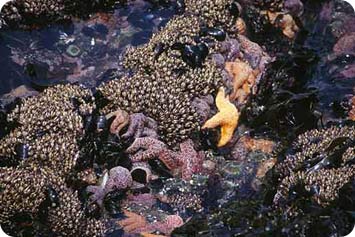Imagine living in a place where crashing waves pound against jagged rocks, the blazing sun bakes the ground, and predators stalk the shore. This is life in the intertidal zone.
 Ochre sea stars crowd the middle and low intertidal zones where their main food source, the mussel, is abundant. Credit: Multi-Agency Rocky Intertidal Network (MARINe)
Ochre sea stars crowd the middle and low intertidal zones where their main food source, the mussel, is abundant. Credit: Multi-Agency Rocky Intertidal Network (MARINe)The intertidal zone is the area on a shoreline between the high and low tides, and it offers an abundance of nourishment for marine life. Nutrients washed down from the land and gases churned by the waves feed algae and plankton, which form the base of the intricate intertidal food web.
But intertidal life is tough. Waves constantly threaten to sweep organisms away or smash them against the rocks or sand. Mussels use fine threads to cling to rocks, while sea stars and anemones stay in place with suction cups.
When the tide recedes, organisms face the risk of drying out from exposure to the sun and air. Crabs and other mobile animals seek shelter in cool rock crevices, while sea slugs, called nudibranchs, burrow in the mud. Clams and mussels close their shells tightly to hold in water, and some marine snails secrete a coating of slime to keep their bodies moist during the daily dry spell.
Intertidal dwellers also use these adaptations to weather storms. Too much rain can expose creatures to large amounts of fresh water, disrupting the internal balance of salt they need to live.
For organisms that have adapted to the dangers of sun and surf, life in the intertidal zone means an abundant food supply. And the fact that intertidal habitats all over the world teem with life proves that many creatures are up to the challenge.


